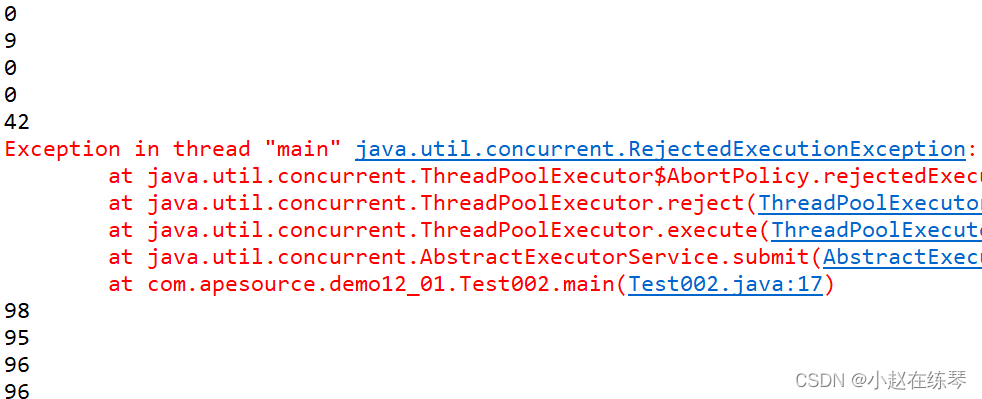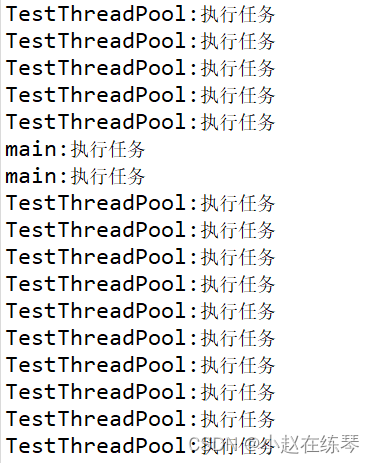前言
线程池想必大家都有所耳闻,今天讲一讲线程池的几种基本的拒绝策略
目录
一.四种线程池拒绝策略(handler)
当线程池的线程数达到最大线程数时,需要执行拒绝策略。拒绝策略需要实现 RejectedExecutionHandler 接口,并实现 rejectedExecution(Runnable r, ThreadPoolExecutor executor) 方法。不过 Executors 框架已经为我们实现了 4 种拒绝策略:
AbortPolicy(默认)
:丢弃任务并抛出 RejectedExecutionException 异常。
CallerRunsPolicy
:由调用线程处理该任务。
DiscardPolicy
:丢弃任务,但是不抛出异常。可以配合这种模式进行自定义的处理方式。
DiscardOldestPolicy
:丢弃队列最早的未处理任务,然后重新尝试执行任务。
二.线程池默认的拒绝策略
查看java.util.concurrent.ThreadPoolExecutor类的源码,我们可以看到:
/**
* The default rejected execution handler
*/
private static final RejectedExecutionHandler defaultHandler =
new AbortPolicy();线程池的默认拒绝策略为AbortPolicy,即丢弃任务并抛出RejectedExecutionException异常。我们可以通过代码来验证这一点,现有如下代码:
public class ThreadPoolTest {
public static void main(String[] args) {
BlockingQueue<Runnable> queue = new ArrayBlockingQueue<>(100);
ThreadFactory factory = r -> new Thread(r, "TestThreadPool");
ThreadPoolExecutor executor = new ThreadPoolExecutor(5, 5,
0L, TimeUnit.SECONDS, queue, factory);
while (true) {
executor.submit(() -> {
try {
System.out.println(queue.size());
Thread.sleep(10000);
} catch (InterruptedException e) {
e.printStackTrace();
}
});
}
}
}这里是一个默认的线程池,没有设置拒绝策略,设置了最大线程队列是100。运行代码结果如下:

结果是符合预期的,这也证明了线程池的默认拒绝策略是ThreadPoolExecutor.AbortPolicy:丢弃任务并抛出RejectedExecutionException异常。
三.拒绝策略场景分析
1.AbortPolicy
ThreadPoolExecutor.AbortPolicy:丢弃任务并抛出RejectedExecutionException异常。源码解释如下:
/**
* Creates an {@code AbortPolicy}.
*/
public AbortPolicy() { }
/**
* Always throws RejectedExecutionException.
*
* @param r the runnable task requested to be executed
* @param e the executor attempting to execute this task
* @throws RejectedExecutionException always
*/这是线程池默认的拒绝策略,在任务不能再提交的时候,抛出异常,及时反馈程序运行状态。如果是比较关键的业务,推荐使用此拒绝策略,这样子在系统不能承载更大的并发量的时候,能够及时的通过异常发现。
2.DiscardPolicy
ThreadPoolExecutor.DiscardPolicy:丢弃任务,但是不抛出异常。如果线程队列已满,则后续提交的任务都会被丢弃,且是静默丢弃。源码解释如下:
/**
* Creates a {@code DiscardPolicy}.
*/
public DiscardPolicy() { }
/**
* Does nothing, which has the effect of discarding task r.
*
* @param r the runnable task requested to be executed
* @param e the executor attempting to execute this task
*/使用此策略,可能会使我们无法发现系统的异常状态。建议是一些无关紧要的业务采用此策略。例如,某些视频网站统计视频的播放量就是采用的这种拒绝策略。
3.DiscardOldestPolicy
ThreadPoolExecutor.DiscardOldestPolicy:丢弃队列最前面的任务,然后重新提交被拒绝的任务。源码解释如下:
/**
* Creates a {@code DiscardOldestPolicy} for the given executor.
*/
public DiscardOldestPolicy() { }
/**
* Obtains and ignores the next task that the executor
* would otherwise execute, if one is immediately available,
* and then retries execution of task r, unless the executor
* is shut down, in which case task r is instead discarded.
*
* @param r the runnable task requested to be executed
* @param e the executor attempting to execute this task
*/此拒绝策略,是一种喜新厌旧的拒绝策略。是否要采用此种拒绝策略,还得根据实际业务是否允许丢弃老任务来认真衡量。
4.CallerRunsPolicy
ThreadPoolExecutor.CallerRunsPolicy:由调用线程处理该任务 源码解释如下:
/**
* Creates a {@code CallerRunsPolicy}.
*/
public CallerRunsPolicy() { }
/**
* Executes task r in the caller's thread, unless the executor
* has been shut down, in which case the task is discarded.
*
* @param r the runnable task requested to be executed
* @param e the executor attempting to execute this task
*/如果任务被拒绝了,则由调用线程(提交任务的线程)直接执行此任务,我们可以通过代码来验证这一点:
public static void main(String[] args) {
BlockingQueue<Runnable> queue = new ArrayBlockingQueue<>(10);
ThreadFactory factory = r -> new Thread(r, "TestThreadPool");
ThreadPoolExecutor executor = new ThreadPoolExecutor(5, 5,
0L, TimeUnit.SECONDS, queue, factory, new ThreadPoolExecutor.CallerRunsPolicy());
for (int i = 0; i < 1000; i++) {
executor.submit(() -> {
try {
System.out.println(Thread.currentThread().getName() + ":执行任务");
Thread.sleep(1000);
} catch (InterruptedException e) {
e.printStackTrace();
}
});
}
}
把队列最大值改为10,打印输出线程的名称。执行结果如下:

通过结果可以看到,主线程main也执行了任务,这正说明了此拒绝策略由调用线程(提交任务的线程)直接执行被丢弃的任务的。
四.总结
本文介绍和演示了四种线程池拒绝策略,具体使用哪种策略,还得根据实际业务场景才能做出抉择。